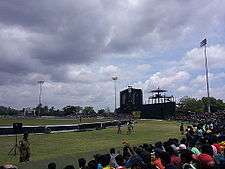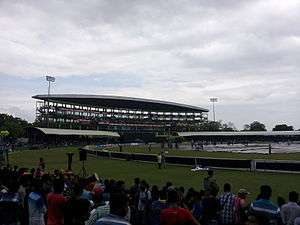Rangiri Dambulla International Stadium
|
During match between Sri Lanka and Pakistan ODI on 30th of August 2014 | |
| Ground information | |
|---|---|
| Location | Dambulla, Central Province |
| Coordinates | 7°51′34″N 80°38′02″E / 7.85944°N 80.63389°ECoordinates: 7°51′34″N 80°38′02″E / 7.85944°N 80.63389°E |
| Establishment | 2000 |
| Capacity | 16800 (approx) |
| Owner | The Golden Temple, Dambulla |
| Operator | Sri Lanka Cricket |
| Tenants | 2010 Asia Cup |
| End names | |
|
Press Box End Scoreboard End | |
| International information | |
| First ODI |
23 March 2001: |
| Last ODI |
31 August 2016: |
| First T20I |
19 November 2014: |
| Last T20I |
22 November 2014: |
|
As of 31 August 2016 Source: Cricinfo | |
Dambulla International Cricket Stadium (Sinhalese: රංගිරි දඹුලු ජාත්යන්තර ක්රීඩාංගනය, Tamil: தம்புள்ள இன்டர்நேஷனல் கிரிக்கெட் ஸ்டேடியம்) is a 30,000[1] seat cricket stadium in Sri Lanka. The Stadium is situated in the Central Province, close to Dambulla on a 60-acre (240,000 m²) site leased from the Rangiri Dambulla Temple, is the first and only International cricket ground in dry zone of Sri Lanka. The stadium is built overlooking the Dambulla Tank (reservoir) and the Dambulla Rock.
History
- The inaugural One Day International (ODI) match was played between Sri Lanka and England in March 2001.
- Floodlights were installed in 2003.
- The stadium returned to international cricket on November 2013 after 3-year period due to its highly criticized floodlight system.
- The stadium currently hosts only Day matches
- Plans are underway to replace the outdated 8 floodlight towers with 4 LED ones.

The ground
Situated in the dry zone, the original rationale behind the project was that it provided Sri Lanka with the potential to host one-day matches throughout the year. Construction was funded by the Board of Control for Cricket in Sri Lanka (BCCSL) and championed by the then BCCSL President, Thilanga Sumathipala. Construction took only 167 days. After construction and the inaugural match it sat idle due to complications with the lease and the contractors. International cricket finally returned in May 2003, the venue staging all seven matches of the tournament because of monsoon rains in the south.
The pitch is bowler friendly. Seamers benefit in the morning because of the high water table and heavy sweating. Spinners benefit in the afternoon when the pitch can crumble.
After 6 years since 2010, the first day-night ODI was held on 28 August 2016, during the ODI series against Australia after upgrading floodlights to ICC Standards.[2] This match was the final ODI for Sri Lankan great Tillakaratne Dilshan.[3]

Ground figures
One Day International
- The highest ODI total at the Rangiri Dambulla International Stadium is 385/7 by Pakistan against Bangladesh on June 21, 2010.
- The lowest ODI total is 88 by England against Sri Lanka on November 18, 2003 and by India against New Zealand on August 10, 2010.
- Mahela Jayawardene has scored 1076 runs and is the highest by a single player at the Rangiri Dambulla International Stadium.
- The highest individual score at stadium is 124 by Shahid Afridi against Bangladesh in the 2010 Asia Cup.
- Muttiah Muralitharan with 42 scalps has captured the most number of wickets at the Rangiri Dambulla International Stadium.
- The best bowling figures recorded at the stadium is 5/23 by Muttiah Muralitharan.
See also
References
- ↑ Rangiri Dambulla International Stadium | Sri Lanka | Cricket Grounds | ESPN Cricinfo. Content.cricinfo.com. Retrieved on 2013-12-23.
- ↑ "SLC to upgrade Dambulla floodlights". espncricinfo. Retrieved 26 August 2016.
- ↑ "Stand-in captain, retiring star in focus as teams scrap for lead". espncricinfo. Retrieved 27 August 2016.
External links
| Wikimedia Commons has media related to Rangiri Dambulla International Stadium. |
